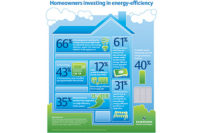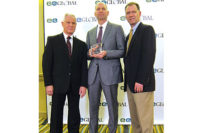A broadening interest in energy efficiency seems to be paying off. New research from Johnson Controls shows interest in energy efficiency has risen 116 percent globally since 2010, with those who set goals taking the biggest strides in reducing energy use.
The Johnson Controls “2013 Energy Efficiency Indicator,” a global survey of more than 3,000 decision makers in 10 countries examining energy-efficiency technologies, practices, and investments, was unveiled at the 24th annual North American Energy Efficiency Forum in Washington.
HVAC Investment
HVAC improvements rank among the top energy-efficiency measures being implemented globally.
When asked, “Which of the following energy-efficiency measures has your company or organization adoped in the last 12 months?” Sixty-nine percent of responders in the U.S. and Canada acknowledged making HVAC energy-efficiency improvements — as did 68 percent of respondents in India and China. Over the next 12 months, 42 percent of worldwide survey participants mentioned HVAC and controls improvements as a top priority.
In addition to an increase in interest for energy efficiency, the survey indicated some momentum for green building certification and green tenant space leasing, though 22 percent of respondents cited a lack of funding as their biggest hurdle to investment.
Setting a Goal
The study found organizations with publicly stated reduction goals were more likely to make strides in energy efficiency than those lacking goals. Approximately 95 percent of organizations with public goals invested in energy efficiency or renewable energy in the past 12 months. Only 55 percent of those with no goals did the same. Among those that set public goals, 73 percent plan to increase energy-efficiency investments, and nearly one-third used external financing to meet those goals.
The report further notes that companies with efficiency goals are 2.7 times more likely to increase investments next year and adopted more energy management practices, which they stated helped the company establish brand value, property value, and other benefits such as drivers for efficiency and renewable energy beyond energy cost savings. Two-thirds of these organizations with public or internal energy-reduction goals are planning to pursue green certification or net-zero buildings in the near future.
Setting goals also proved to be a factor in those who implemented efficiency measures, as they took 50 percent more efficiency measures than institutions without goals.
The survey acknowledged that more organizations and companies are establishing energy-efficiency goals. Seventy-three percent of those surveyed set energy reduction goals within the last year, up 15 percent from two years ago.
Thirty-six percent of U.S./Canada decision makers and 30 percent of those in Australia recognized tax credits and energy-efficiency incentives and rebates as the most important government initiatives.
Twenty-four percent of German responders mentioned interest in low-interest loans, a much higher rate than the 10 percent of responders showing interest in China.
Lack of funding, though, continues to be a big barrier for companies. That, along with internal funding criteria, is the most important barrier to energy-efficiency investments, revealed the survey.
Significantly more respondents from the U.S./Canada region (31 percent) cited capital availability compared to those in Europe (23 percent) or other countries. Lack of technical expertise was cited substantially more often in India (19 percent) and China (17 percent) than in Europe (10 percent), the U.S./Canada (7 percent), or Australia (7 percent).
“The research shows that accountability drives action when it comes to energy efficiency and we think more companies want to find ways to be efficient. However, the barriers that our research points to year after year must be resolved first,” said Dave Myers, president of building efficiency, Johnson Controls.
Information courtesy of Johnson Controls. For more information, visit www.johnsoncontrols.com.
Publication date: 3/3/2014
Want more HVAC industry news and information? Join The NEWS on Facebook, Twitter, and LinkedIn today!




Report Abusive Comment